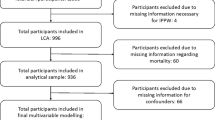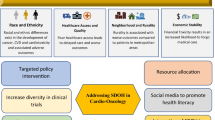Abstract
Background
Social vulnerability is a complex construct which is beyond relying on single measures. If socially vulnerable patients should be identified, we need a composite measure capturing the patient’s overall circumstances. This study presents the development of a social vulnerability index (rSVI) for cancer patients based on administrative data from population-based registers.
Methods
All patients, who died from cancer within 5 years after the cancer diagnosis during 2013–2018 (n = 44,187), were identified and divided in four subcohorts according to survival; index cohort surviving 3–5 years (n = 3044 surviving 3–5 years), cohort 1 (n = 27,170 surviving < 1 year), cohort 2 (n = 9450 surviving 1–2 years), and cohort 3 (n = 4523 surviving 2–3 years). Variables from ten registries on health and social issues were linked to each individual patient. Variables of interest were weighted to construct the rSVI using the index-cohort. rSVI was subsequently tested on the three other cohorts for validation.
Results
The rSVI included weighted values for marital status, ethnicity, education, income, unemployment, psychiatric comorbidity, and somatic comorbidity. The validity of the rSVI was supported by the expected trend in proportions of vulnerable patients when applied on the other cohorts. Single social measures appeared insufficient in identification of vulnerable patients when compared with the rSVI.
Conclusion
The rSVI provides a tool for identification of socially vulnerable cancer patients using administrative data. The index requires further validation in other patient groups and is tested against other measures of vulnerability. Future perspectives are to use the rSVI as predictor of advanced cancer patients’ use of healthcare services.

Similar content being viewed by others
Data availability
The data will not be deposited due to Danish law.
Code availability
Stata codes are available on request.
Change history
22 December 2022
A Correction to this paper has been published: https://doi.org/10.1007/s00520-022-07555-9
References
Dalton SO, Schuz J, Enyholm G, Johansen C, Kjaer SK, Steding-Jessen M et al (2008) Social inequality in incidence of and survival from cancer in a population-based study in Denmark, 1994-2003: summary of findings. Eur J Cancer 44:2074–85. https://doi.org/10.1016/j.ejca.2008.06.018
Dalton SO, Olsen MH, Johansen C, Olsen JH, Andersen KK (2019) Socioeconomic inequality in cancer survival - changes over time. A population-based study, Denmark, 1987–2013. Acta Oncol 58:737–44. https://doi.org/10.1080/0284186x.2019.1566772
Neamtu I, Westergaard-Nielsen N (2013) Sources and impact of rising inequality in Denmark. Center for Corporate Performance, Aarhus University. Available from: https://www.cbs.dk/files/cbs.dk/new_papers_4.pdf. Accessed 19 Sept 2021
Udesen CH, Skaarup C, Petersen MNS, Ersbøll AK (2020). Social inequality in health and disease - the development in Denmark in the period 2010–2017 [DANISH]. The Danish Health Authority. Available from: https://www.sst.dk/-/media/Udgivelser/2020/Ulighed-i-sundhed/Social-ulighed-i-sundhed-og-sygdom-tilgaengelig.ashx?la=da&hash=CB63CAD067D942FE54B99034085E78BE9F486A92. Accessed 19 Sept 2021
Andrew MK, Keefe JM (2014) Social vulnerability from a social ecology perspective: a cohort study of older adults from the National Population Health Survey of Canada. BMC Geriatr 14. https://doi.org/10.1186/1471-2318-14-90
Zimmermann A (2017) Social vulnerability as an analytical perspective. Discussion Paper No. 4, Berlin: Population Europe. Available from: https://population-europe.eu/files/documents/pe_discussionpaper4_final_web.pdf. Accessed 30 Apr 2021
Ruof MC (2004) Vulnerability, vulnerable populations, and policy. Kennedy Inst Ethics J 14:411–25. https://doi.org/10.1353/ken.2004.0044
Galobardes B, Shaw M, Lawlor DA, Lynch JW, Davey Smith G (2006) Indicators of socioeconomic position (part 1). J Epidemiol Community Health 60:7–12. https://doi.org/10.1136/jech.2004.023531
Andrew MK, Mitnitski AB, Rockwood K (2008) Social vulnerability, frailty and mortality in elderly people. PLoS ONE 3:e2232. https://doi.org/10.1371/journal.pone.0002232
Schmidt M, Schmidt SAJ, Adelborg K, Sundboll J, Laugesen K, Ehrenstein V et al (2019) The Danish health care system and epidemiological research: from health care contacts to database records. Clin Epidemiol 11:563–91. https://doi.org/10.2147/CLEP.S179083
Thygesen LC, Ersboll AK (2014) When the entire population is the sample: strengths and limitations in register-based epidemiology. Eur J Epidemiol 29:551–8. https://doi.org/10.1007/s10654-013-9873-0
Silver JK, Raj VS, Fu JB, Wisotzky EM, Smith SR, Kirch RA (2015) Cancer rehabilitation and palliative care: critical components in the delivery of high-quality oncology services. Support Care Cancer 23:3633–43. https://doi.org/10.1007/s00520-015-2916-1
Moustsen IR, Larsen SB, Vibe-Petersen J, Trier K, Bidstrup PE, Andersen KK et al (2015) Social position and referral to rehabilitation among cancer patients. Acta Oncol 54:720–6. https://doi.org/10.3109/0284186x.2014.997836
Oksbjerg Dalton S, Halgren Olsen M, Moustsen IR, Wedell Andersen C, Vibe-Petersen J, Johansen C (2019) Socioeconomic position, referral and attendance to rehabilitation after a cancer diagnosis: a population-based study in Copenhagen, Denmark 2010–2015. Acta Oncol 58:730–6. https://doi.org/10.1080/0284186x.2019.1582800
Adsersen M, Thygesen LC, Neergaard MA, Jensen AB, Sjogren P, Damkier A et al (2019) Cohabitation status influenced admittance to specialized palliative care for cancer patients: a Nationwide Study from the Danish Palliative Care Database. J Palliat Med 22:164–72. https://doi.org/10.1089/jpm.2018.0201
Sampedro Pilegaard M, Knold Rossau H, Lejsgaard E, Kjer Møller JJ, Jarlbaek L, Dalton SO, et al. (2020) Rehabilitation and palliative care for socioeconomically disadvantaged patients with advanced cancer: a scoping review. Acta Oncol:1–12. https://doi.org/10.1080/0284186x.2020.1827156
Danish Research Center for Equality in Cancer (COMPAS). [cited 2021 10–18]. Available from: https://www.compas.dk/]
Gjerstorff ML (2011) The Danish Cancer Registry. Scand J Public Health 39:42–5. https://doi.org/10.1177/1403494810393562
Helweg-Larsen K (2011) The Danish Register of causes of death. Scand J Public Health 39:26–9. https://doi.org/10.1177/1403494811399958
Schmidt M, Pedersen L, Sorensen HT (2014) The Danish Civil Registration System as a tool in epidemiology. Eur J Epidemiol 29:541–549. https://doi.org/10.1007/s10654-014-9930-3
Schmidt M, Schmidt SAJ, Sandegaard JL, Ehrenstein V, Pedersen L, Sørensen HT (2015) The Danish National patient registry: A review of content, data quality, and research potential. Clin Epidemiol 7:449–490. https://doi.org/10.2147/CLEP.S91125
The Danish Agency for Labour Market and Recruitment (2021) DREAM vejledning version 46 [DANISH]. Available from: https://www.dst.dk/Site/Dst/SingleFiles/GetArchiveFile.aspx?fi=6705686690&fo=0&ext=forskning. Accessed 18 Oct 2021
Jensen VM, Rasmussen AW (2011) Danish education registers. Scand J Public Health 39:91–94. https://doi.org/10.1177/1403494810394715
Baadsgaard M, Quitzau J (2011) Danish registers on personal income and transfer payments. Scand J Public Health 39:103–105. https://doi.org/10.1177/1403494811405098
Danish National Board of Health (2010) Register declaration for The National Registry of Alcohol Treatment [DANISH]. Copenhagen. Available from: https://sundhedsdatastyrelsen.dk/-/media/sds/filer/registre-og-services/nationale-sundhedsregistre/sygedomme-laegemidler-og-behandlinger/alkoholregisteret/registerdeklaration-nationale-alkoholbehandlings-register.pdf?la=da. Accessed 18 Oct 2021
The Danish Health Authority (2015) Register declaration for The Registry of Drug Abusers Undergoing Treatment [DANISH]. Copenhagen. Available from: https://sundhedsdatastyrelsen.dk/-/media/sds/filer/registre-og-services/nationale-sundhedsregistre/sygedomme-laegemidler-og-behandlinger/stofmisbrugere-i-behandling/registerdeklaration-for-stofmisbrugere-i-behandling.pdf?la=da#:~:text=0.4%20Form%C3%A5l%20med%20register%20Registerets,opfylde%20Danmarks%20internationale%20forpligtigelser%20ifht. Accessed 18 Oct 2021
Statistics Denmark. Crime statistics [DANISH]. Copenhagen. [cited 2021 10–18]. Available from: https://www.dst.dk/da/Statistik/dokumentation/Times/kriminalstatistik].
Hjollund NH, Larsen FB, Andersen JH (2007) Register-based follow-up of social benefits and other transfer payments: Accuracy and degree of completeness in a Danish interdepartmental administrative database compared with a population-based survey. Scand J Public Health 35:497–502. https://doi.org/10.1080/14034940701271882
Lynge E, Sandegaard JL, Rebolj M (2011) The Danish National Patient Register. Scand J Public Health 39:30–33. https://doi.org/10.1177/1403494811401482
Ferlay J, Colombet M, Soerjomataram I, Dyba T, Randi G, Bettio M et al (2018) Cancer incidence and mortality patterns in Europe: Estimates for 40 countries and 25 major cancers in 2018. Eur J Cancer 103:356–387. https://doi.org/10.1016/j.ejca.2018.07.005
Hurst SA (2008) Vulnerability in research and health care; describing the elephant in the room? Bioethics 22:191–202. https://doi.org/10.1111/j.1467-8519.2008.00631.x
Hagenaars AJM, Vos Kd, Zaidi MA (1994) Poverty statistics in the late 1980s: research based on micro-data. Luxembourg: Office for Official Publications of the European Communities. ISBN: 9282689824
Benjaminsen L, Birkelund JF, Ememark MH, Andrade SB (2018) Socially marginalized citizens use of the welfare system [DANISH]. Copenhagen. VIVE - Viden til Velfærd. Available from: https://www.vive.dk/media/pure/6999/1717876. Accessed 20 Aug 2021
Quan H, Sundararajan V, Halfon P, Fong A, Burnand B, Luthi JC et al (2005) Coding algorithms for defining comorbidities in ICD-9-CM and ICD-10 administrative data. Med Care 43:1130–1139. https://doi.org/10.1097/01.mlr.0000182534.19832.83
UNESCO (2012) International Standard Classification of Education (ISCED) 2011. UNESCO Institute for Statistics. [Available from: http://uis.unesco.org/sites/default/files/documents/international-standard-classification-of-education-isced-2011-en.pdf]
Nguyen TN, Ngangue P, Bouhali T, Ryan BL, Stewart M, Fortin M (2019) Social vulnerability in patients with multimorbidity: a cross-sectional analysis. Int J Environ Res Public Health 16:1244. https://doi.org/10.3390/ijerph16071244
Kisely S, Forsyth S, Lawrence D (2016) Why do psychiatric patients have higher cancer mortality rates when cancer incidence is the same or lower? Aust N Z J Psychiatry 50:254–263. https://doi.org/10.1177/0004867415577979
Kreek MJ (2011) Extreme marginalization: addiction and other mental health disorders, stigma, and imprisonment. Ann N Y Acad Sci 1231:65–72. https://doi.org/10.1111/j.1749-6632.2011.06152.x
Rutjes AW, Reitsma JB, Coomarasamy A, Khan KS, Bossuyt PM (2007) Evaluation of diagnostic tests when there is no gold standard. A review of methods. Health Technol Assess 11. https://doi.org/10.3310/hta11500
Sánchez-Garrido N, Aguilar-Navarro SG, Ávila-Funes JA, Theou O, Andrew M, Pérez-Zepeda MU (2021) The social vulnerability index, mortality and disability in mexican middle-aged and older adults. Geriatrics 6. https://doi.org/10.3390/geriatrics6010024
Wallace LMK, Theou O, Pena F, Rockwood K, Andrew MK (2015) Social vulnerability as a predictor of mortality and disability: cross-country differences in the survey of health, aging, and retirement in Europe (SHARE). Aging Clin Exp Res 27:365–372. https://doi.org/10.1007/s40520-014-0271-6
Berends L, Garfield JB, Manning V, Buykx P, Lam T, Mugavin J et al (2016) Social disadvantage and past treatment among clients entering public alcohol and drug services in two Australian states. Int J Drug Policy 29:88–90. https://doi.org/10.1016/j.drugpo.2015.12.018
Maschi T, Viola D, M TH, Harrison W, Koskinen L, Bellusa S (2014) Bridging community and prison for older adults: invoking human rights and elder and intergenerational family justice. Int J Prison Health 10:55–73. https://doi.org/10.1108/ijph-04-2013-0017
Gilbert T, Neuburger J, Kraindler J, Keeble E, Smith P, Ariti C et al (2018) Development and validation of a Hospital Frailty Risk Score focusing on older people in acute care settings using electronic hospital records: an observational study. Lancet 391:1775–1782. https://doi.org/10.1016/s0140-6736(18)30668-8
Allemani C, Weir HK, Carreira H, Harewood R, Spika D, Wang XS et al (2015) Global surveillance of cancer survival 1995–2009: analysis of individual data for 25,676,887 patients from 279 population-based registries in 67 countries (CONCORD-2). Lancet 385:977–1010. https://doi.org/10.1016/s0140-6736(14)62038-9
Corbett T, Bridges J (2019) Multimorbidity in older adults living with and beyond cancer. Curr Opin Support Palliat Care 13:220–224. https://doi.org/10.1097/spc.0000000000000439
Acknowledgements
Special thanks to the Danish Research Centre for Equality in Cancer (COMPAS) for funding and focusing on enhancing the area of social inequality in cancer. Thanks also go to the University of Southern Denmark and REHPA, The Danish Knowledge Centre for Rehabilitation and Palliative Care for funding this project.
Funding
This study was supported by The Danish Cancer Society [R223-A13094-18-S68] via the Danish Research Center for Equality in Cancer (COMPAS), faculty scolarship from the Faculty of Health Sciences on University of Southern Denmark, and The Danish Knowledge Centre for Rehabilitation and Palliative care, REHPA.
Author information
Authors and Affiliations
Contributions
1. JJKM, KlC, and LJ designed the study; JJKM performed the data management and analyses; all authors contributed to the interpretation of the results.
2. JJKM drafted the article. KlC, MSP, SM, and LJ revised the drafts critically for important intellectual content.
3. All authors approved the final version of the article to be published.
4. All authors agree to be accountable for all aspects of the work in ensuring that questions related to the accuracy or integrity of any part of the work are appropriately investigated and resolved.
Corresponding author
Ethics declarations
Ethics approval
Not required for registry-based studies in Denmark.
Consent to participate
Not required for registry-based studies in Denmark.
Consent for publication
Not required for registry-based studies in Denmark.
Conflict of interest
The authors declare no competing interests.
Additional information
Publisher's note
Springer Nature remains neutral with regard to jurisdictional claims in published maps and institutional affiliations.
Supplementary Information
Below is the link to the electronic supplementary material.
Rights and permissions
Springer Nature or its licensor (e.g. a society or other partner) holds exclusive rights to this article under a publishing agreement with the author(s) or other rightsholder(s); author self-archiving of the accepted manuscript version of this article is solely governed by the terms of such publishing agreement and applicable law.
About this article
Cite this article
Møller, JJ.K., la Cour, K., Pilegaard, M.S. et al. Identification of socially vulnerable cancer patients — development of a register-based index (rSVI). Support Care Cancer 30, 5277–5287 (2022). https://doi.org/10.1007/s00520-022-06937-3
Received:
Accepted:
Published:
Issue Date:
DOI: https://doi.org/10.1007/s00520-022-06937-3




